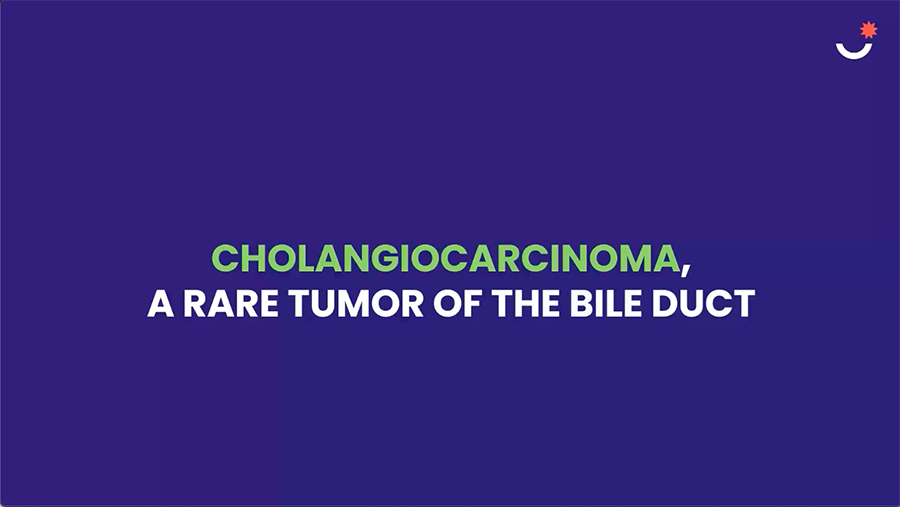Cholangiocarcinoma, a cancer of the bile ducts, is a rare and aggressive tumor. In most cases there is no identified causes, however it can often be linked to other risk factors such as inflammatory diseases, cirrhosis, or infections.
Surgery is the only potentially curative solution, but it is only possible for a limited number of patients and the risk of relapse remains high. Chemotherapy and immunotherapy are the standard therapy for patients with cholangiocarcinoma who are not eligible for surgery or with a disease that has progressed after surgery. Developments in immunotherapy and new targeted therapies bring greater hope and better quality of life for patients.
Intrahepatic or extrahepatic primary bile duct cancer
Cholangiocarcinoma is a primary cancer, rather than a metastatic cancer, that has spread from a primary tumor to another organ. It develops in the bile ducts that carry the digestive fluid bile from the gall bladder to the small intestine. There are three main subtypes of cholangiocarcinoma1 that depend on the location of the tumor in the biliary system:
There is considerable regional variation, but the latest data suggest that localization of the cholangiocarcinoma is intrahepatic more or less half the time and extrahepatic the other half.2
A rare and aggressive form of cancer
Cholangiocarcinoma is a rare and aggressive tumor. It affects approximately 8,000 people in the United States3 and 2,000 in France4. Cholangiocarcinoma is more common in regions with a higher incidence of infections caused by a parasite which infects the liver. Thailand (90 cases per 100,000 population3) has the highest incidence in the world, followed by China and Korea.
The actual number of cases is probably underestimated, since this form of cancer is difficult to diagnose. It is sometimes wrongly diagnosed as another type of cancer. 3

A cancer often linked to medical history
Several factors increase the risk of developing a bile duct cancer. Frequently, they are related with a history of previous disease or inflammation of the bile ducts. 5 Other risk factors also include age (patients are on average 70 years old6), obesity, diabetes, and exposure to certain types of chemicals.
Preventing cholangiocarcinoma
Cholangiocarcinoma can be partially prevented through appropriate lifestyle and health measures. Adopting a balanced diet rich in fruits and vegetables, combined with regular physical activity, helps maintain a healthy liver. Similarly, limiting alcohol consumption and avoiding smoking are essential measures to protect the liver.
It is crucial to get vaccinated against the hepatitis B virus (HBV) to prevent chronic infections that may lead to this cancer. Treating any existing hepatitis, especially hepatitis B and C, reduces the risk of liver damage that could develop into cholangiocarcinoma. Traveling to endemic areas, such as certain Southeast Asian regions where liver parasites are present, requires special vigilance: drinking potable water, consuming well-cooked food, and following local health recommendations.
By combining these various strategies, it is possible to significantly reduce the risk of developing cholangiocarcinoma.5
Diagnosis: imaging and biopsy
Diagnostic tests depend on the signs and symptoms, age, general health, as well as the results of previous tests. Bile duct cancer is often diagnosed late because many patients display no signs or symptoms. The first signs of the disease are often non-specific and appear when the tumor is large and compresses the large bile ducts, which can cause jaundice (yellowing of the skin) in extrahepatic cholangiocarcinoma.
Other symptoms may appear, such as itching, pale stools, dark urine, abdominal pain, weight loss, and fever. However, these symptoms are not specific to the diseases and may lead to a delayed cancer diagnosis.4

However, the intrahepatic form may be found by chance through X-rays or MRI taken for other reasons, or show up as an anomaly in blood tests, or because bile secretion is reduced or stops completely. Unfortunately, there are no reliable biological markers specific to these bile duct cancers.
Imaging alone (ultrasound, scan or MRI) can detect the tumor, locate it and determine whether it has spread to other organs. It can also help determine if the tumor can be surgically removed (whether it is resectable or unresectable7). Next, if there is a suspicion, molecular and histological analyses (on a sample of a liver fragment) will help to clarify the diagnosis.
Surgery dominates treatment options
Surgical resection is the only potential option for curing cholangiocarcinoma. If surgery is not possible, palliative chemotherapy or radiation therapy may be offered. A full liver transplant may also be considered. It is also recommended to treat the jaundice at the same time as the cancer.
New therapies are being developed for this aggressive disease with limited treatment options currently available.
Immunotherapy aims to boost the body’s natural defenses to fight the cancer and also brings new hope for cholangiocarcinoma patients.
Furthermore, over the past few years, a number of targeted therapies have been approved. These therapies target the genes, proteins or surrounding tissue that help the cancer to survive and grow. They block cancer cells from proliferating without damaging healthy cells. These treatments are for patients in whom a targetable mutation has been identified.
Therefore, it is crucial to perform molecular testing to identify such mutations. These tests help determine whether a patient could benefit from targeted therapies, thus offering a more personalized approach to combating cholangiocarcinoma.

AND SERVIER?
To address the ever-increasing incidence of cancer and the growing need for therapeutic solutions, we have made oncology a priority focus for development. Our ambition is to become an innovative player focused on developing medicines targeting hard-to-treat cancers with high unmet medical needs. We wish to initiate therapeutic progress where generally speaking needs are not yet met, known as hard-to-treat cancers, such as digestive cancers (stomach cancer, pancreatic cancer, and cholangiocarcinoma), glioma, or brain tumors, hematologic cancers (acute myeloid leukemia, acute lymphoblastic leukemia).
Servier leads its R&D programs around two approaches:
WHAT YOU NEED TO KNOW
1 – Cholangiocarcinoma Foundation – https://cholangiocarcinoma.org/defined/https://cholangiocarcinoma.org/learn-about-cholangiocarcinoma – consulted on 28/11/2024
2 – American Cancer Society – Global Trends in Intrahepatic and Extrahepatic Cholangiocarcinoma Incidence From 1993 to 2012 – https://acsjournals.onlinelibrary.wiley.com/doi/10.1002/cncr.32803
3 – American Cancer Society/ Key statistics for bile Duct Cancer – https://www.cancer.org/cancer/types/bile-duct-cancer/about/key-statistics.html
consulted on 17/02/2025
4 – AFEF, Société Française d’Hépatologie – https://afef.asso.fr/cholangiocarcinome/ – consulted on 17/02/2025
5 – American cancer society – https://www.cancer.net/cancer-types/bile-duct-cancer-cholangiocarcinoma/risk-factors-and-prevention – consulted on 04/12/2024
6 – Cholangiocarcinoma foundation – https://cholangiocarcinoma.org/key-statistics/ – consulted on 17/02/2025
7 – Société savante des maladies et cancer de l’appareil digestif, Cholangiocarcinome (cancer des voies biliaires) – https://www.snfge.org/grand-public/maladies-digestives/cholangiocarcinome-cancer-voies-biliaires – consulted on 04/12/2024

